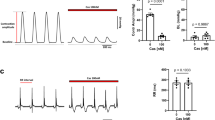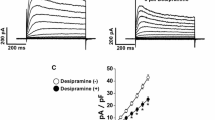Abstract
The ability of a series of synthetic analogues of ω-conopeptides MVIIA (SNX-111) and TVIA (SNX-185) to prevent electrically-evoked norepinephrine release from rat tail artery and hippocampal slice preparations was determined in an effort to identify voltage-sensitive calcium channel (VSCC) blockers that selectively target N-type VSCCs in central nervous system tissue. Electrical field stimulation (3 Hz, 1 ms in duration, 80 V for 1 min) caused a high and consistent tritium outflow from rat tail artery and hippocampal slice preparations preloaded with [3H]-norepinephrine. All conopeptides, chosen for their selective affinities for high-affinity SNX-111 binding sites (i.e., N-type VSCCs) over high-affinity ω-conopeptides MVIIC (SNX-230) binding sites (i.e., P/Q-type VSCCs), produced a concentration-dependent inhibition of calcium dependent electrically-evoked tritium outflow from both tail arteries and hippocampal slices; IC50s ranged from 1.2 nM to 1.2 μM. Blocking potencies (IC50s) in the tail artery assay were significantly correlated with those measured in the hippocampal slice preparation (r = 0.91, P = 0.00000012). There was a significant correlation between IC50s for blockade of hippocampal norepinephrine release and the inhibition of high-affinity [125I]-SNX-111 binding in rat brain synaptosomes (r = 0.76, P = 0.00028). Blockade of hippocampal norepinephrine release was not significantly correlated with the inhibition of high-affinity SNX-230 binding (r = 0.46, P = 0.056). Maximum inhibition of tritium outflow in the tail artery assay was 22 ± 1.4% of control, approximating the value (20.9 ± 16.0% of control) obtained in the absence of extracellular Ca2+. In contrast, the maximum inhibition of tritium release from hippocampal slices was 36.8 ± 2.5% of control (P < 0.05, compared to that of the tail artery assay). These results suggest that (1) N-type VSCCs alone mediate low frequency electrical stimulation-evoked neurotransmitter release from peripheral sympathetic efferents (tail artery) while both N-type and non-N type(s) mediate neurotransmitter release from CNS neurons (hippocampus); and (2) analogues of ω-conopeptides MVIIA and TVIA do not differentiate between N-type VSCCs mediating norepinephrine release from central and peripheral neural tissues.
Similar content being viewed by others
Author information
Authors and Affiliations
Additional information
Received: 12 June 1997 / Accepted: 17 October 1997
Rights and permissions
About this article
Cite this article
Wang, YX., Bezprozvannaya, S., Bowersox, S. et al. Peripheral versus central potencies of N-type voltage-sensitive calcium channel blockers. Naunyn-Schmiedeberg's Arch Pharmacol 357, 159–168 (1998). https://doi.org/10.1007/PL00005150
Issue Date:
DOI: https://doi.org/10.1007/PL00005150




